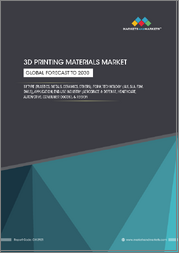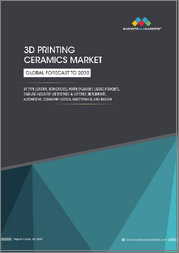
|
시장보고서
상품코드
1373584
세계의 헬스케어 산업용 3D 프린팅 재료 시장(2016-2030년) : 재료 유형별, 용도별, 지역별, 기회 및 예측Healthcare 3-D Printing Materials Market Assessment, By Material Type, By Application, By Region, Opportunities, and Forecast, 2016-2030F |
||||||
세계 헬스케어 산업용 3D 프린팅 재료 시장 규모는 2022년 20억 3,000만 달러에서 예측 기간 동안 9.2%의 CAGR을 기록하며 2030년 41억 달러 규모로 성장할 것으로 예상됩니다.
헬스케어 산업용 3D 프린팅 재료 시장은 의료기기, 임플란트, 보철물, 해부학 모델을 맞춤화하여 개별 환자의 해부학적 특징과 고유한 요구에 정확하게 맞출 수 있는 개인화 능력 등 몇 가지 주요 요인에 의해 크게 촉진되고 있습니다. 이러한 높은 수준의 개인화는 치료 결과를 향상시킬 뿐만 아니라 환자의 만족도와 편안함도 향상시킵니다.
또한, 3D 프린팅이 제공하는 효율성과 시간 절약의 이점은 빠르게 변화하는 의료 환경에서 가장 중요합니다. 이 기술은 신속한 프로토타이핑을 가능하게 하고 의료기기 및 부품의 제조 공정을 간소화하여 신제품의 시장 출시 시간을 단축합니다. 이는 적시에 개입하는 것이 결과에 큰 영향을 미치기 때문에 긴급한 사례와 즉각적인 의료 솔루션이 필요한 환자에게 특히 중요합니다.
또한, 3D 프린팅 재료의 지속적인 혁신과 발전도 시장을 발전시키고 있습니다. 생체 적합성, 생체흡수성 및 특수 의료용 재료의 개발은 복잡하고 내구성이 뛰어나며 안전한 의료기기를 만들 수 있는 새로운 가능성을 열어주었습니다. 이러한 재료는 인체 조직의 특성을 충실하게 모방할 수 있기 때문에 임플란트에 가까운 적합성을 제공하여 생체 적합성을 높일 수 있습니다.
세계 헬스케어 산업용 3D 프린팅 재료 시장을 조사했으며, 시장 정의와 개요, 시장 규모 추이 및 예측, 각종 부문별·지역별 상세 분석, 산업 구조, 시장 성장에 영향을 미치는 요인 분석, 사례 연구, 경쟁 상황, 주요 기업 개요 등의 정보를 정리하여 전해드립니다.
목차
제1장 조사 방법
제2장 프로젝트 범위와 정의
제3장 세계의 헬스케어 산업용 3D 프린팅 재료 시장에 대한 COVID-19의 영향
제4장 러시아·우크라이나 전쟁의 영향
제5장 주요 요약
제6장 고객의 소리
- 시장 인식과 제품 정보
- 브랜드 인지도와 로열티
- 구입 결정시에 고려되는 요소
- 구입 빈도
- 구입 매체
제7장 세계의 헬스케어 산업용 3D 프린팅 재료 시장 전망
- 시장 규모와 예측
- 유형별
- 폴리젖산(PLA)
- 나일론(PA)
- 폴리카보네이트(PC)
- 아크릴로니트릴 부타디엔 스티렌(ABS)
- 티타늄
- 코발트 크롬
- 스테인리스강
- 열가소성 폴리우레탄(TPU)
- 기타
- 용도별
- 보철물
- 의료용 임플란트
- 수술 가이드
- 조직공학
- 기타
- 지역별
- 북미
- 유럽
- 남미
- 아시아태평양
- 중동 및 아프리카
- 기업 점유율
제8장 세계의 헬스케어 산업용 3D 프린팅 재료 시장 전망 : 지역별
- 북미
- 유럽
- 남미
- 아시아태평양
- 중동 및 아프리카
- 시장 규모와 예측
- 유형별
- 용도별
- 국가별
제9장 공급측 분석
- 제조능력 : 기업별
- 제조 규모 : 기업별
- 운전 효율 : 기업별
- 주요 공장 소재지(최대 25개소)
제10장 시장 매핑
제11장 거시적 환경과 산업 구조
- 수급 분석
- 수출입 분석
- 공급망/밸류체인 분석
- PESTEL 분석
- Porter's Five Forces 분석
제12장 시장 역학
- 성장 촉진요인
- 성장 억제요인(과제·제약)
제13장 주요 기업 상황
- 시장 리더 상위 5개사 경쟁 매트릭스
- 시장 리더 상위 5개사 시장 매출 분석
- M&A·합작투자(해당되는 경우)
- SWOT 분석(참여 5개사)
- 특허 분석(해당되는 경우)
제14장 가격 분석
제15장 사례 연구
제16장 주요 기업 전망
- Stratasys
- 3D Systems, Inc
- Formlabs
- Carbon, Inc
- EOS
- HP Development Company, L.P
- Materialise
- Evonik Industries AG
- Arkema
- OXFORD PERFORMANCE MATERIALS, INC
제17장 전략적 추천사항
제17장 당사 소개와 면책사항
ksm 23.11.14Global Healthcare 3-D Printing Materials Market size was valued at USD 2.03 billion in 2022, which is expected to grow to USD 4.1 billion in 2030 with a CAGR of 9.2% during the forecast period between 2023 and 2030. The market for 3D printing materials in the healthcare sector is significantly propelled by several key drivers including the ability to customize and personalize medical devices, implants, prosthetics, and anatomical models to precisely match individual patient anatomies and unique needs is a transformative factor. This high degree of personalization not only enhances treatment outcomes but also increases patient satisfaction and comfort.
Furthermore, the efficiency and time-saving advantages offered by 3D printing are paramount in the fast-paced healthcare environment. The technology enables rapid prototyping and streamlines production processes for medical devices and components, reducing the time it takes to bring new products to the market. This is particularly critical in emergency cases or for patients in need of immediate medical solutions, where timely intervention can significantly impact outcomes.
Moreover, continuous innovations and advancements in 3D printing materials drive the market forward. The development of biocompatible, bioresorbable, and specialized medical-grade materials opens new possibilities for creating intricate, durable, and safe medical devices. These materials can closely mimic the properties of human tissues, providing a closer match for implants and enhancing their biocompatibility.
Increasing Dental Diseases to Drive the Requirement for 3D Printing Materials for Medicinal Usage
The rise in dental diseases has significantly fuelled the demand for 3D printing materials within the healthcare market, particularly in the dental industry. The capability of 3D printing to offer personalized dental solutions such as crowns, bridges, implants, and orthodontic devices is a critical factor. It enables the rapid production of dental prosthetics, improving efficiency and reducing delivery time for patients needing urgent dental care. Furthermore, 3D printing enhances the fabrication of precise dental implants and prosthetics, closely resembling natural teeth, meeting the growing demand for such solutions. The technology's utilization in orthodontics for creating tailored devices like clear aligners and retainers contributes to effective teeth alignment and bite correction. Additionally, 3D printing facilitates accurate dental surgical planning, resulting in better surgical outcomes.
For instance, in 2022, World Health Organization stated that over the past three decades, the worldwide incidence of oral diseases has surged by an additional one billion cases. This rising prevalence of dental conditions is expected to fuel the demand for 3D printing materials in the field of medical applications.
Growing Adoption of Prosthetics to Drive Demand for 3D Printing Materials in the Healthcare Sector
The increasing utilization and acceptance of prosthetics across various healthcare applications are major catalysts propelling the demand for 3D printing materials. Prosthetics play a vital role in improving the quality of life for individuals with limb loss or limb impairment. Traditional manufacturing methods for prosthetics often involve complex and time-consuming processes, whereas 3D printing offers a more efficient and customizable solution. Moreover, 3D printing technology enables the production of prosthetics with intricate geometries and lightweight structures, enhancing usability and minimizing discomfort for the wearer.
For instance, based on statistics from the Artificial Limb Service, amputations among individuals with diabetes rose by 38% from 2016 to 2020. This represents an increase from 806 amputations recorded five years prior to 1,111 amputations reported during 2021. This rise in amputation cases leads to increased usage of prosthetics which in turn drives the demand for 3D printing materials.
Cost Saving and Waste Reduction to Drive Demand for 3D Printing Materials
3D printing, also known as additive manufacturing, revolutionizes manufacturing processes by optimizing material usage and significantly contributing to cost-efficiency. Unlike traditional subtractive manufacturing processes, where material is cut or shaped from a larger block, 3D printing builds the object layer by layer, using only the necessary amount of material. Additionally, 3D printing ensures maximum material efficiency by using the exact quantity needed for each layer of the object. In contrast, traditional manufacturing typically incurs substantial material wastage during shaping and cutting processes. This heightened efficiency minimizes material waste and reduces overall material expenses.
For instance, using 3D printing, the turbine core is manufactured as a single, integrated piece, drastically reducing the overall production time by eliminating the need for core assembly. Consequently, this innovation enables substantial cost reductions of up to 75% for smaller production batches. These advantages over traditional methods drive the demand for healthcare 3D printing materials.
Impact of COVID-19
The healthcare 3-D printing materials market witnessed a significant impact due to the COVID-19 pandemic, which experienced an unprecedented surge in demand for these specialized materials. The pandemic led to an urgent and unprecedented demand for critical medical supplies like face shields, ventilator components, swabs, and other personal protective equipment (PPE). Consequently, 3D printing contributed to the rapid production of testing and diagnostic devices, including nasal swabs and test kit components. Additionally, 3D printing contributed to the rapid production of testing and diagnostic devices, including nasal swabs and test kit components. Finally, with a surge in remote healthcare, there was an increased demand for remote monitoring devices. 3D printing facilitated the production of wearable devices and accessories that aided in telehealth initiatives, allowing for efficient monitoring of patients, and reducing in-person visits.
Impact of Russia-Ukraine War
The conflict between Russia and Ukraine had a noticeable impact on the healthcare 3-D printing materials market. In the wake of the Russian invasion in February 2022, Ukrainian troops showcased ingenuity by utilizing ammunition produced using 3D printers. Furthermore, these printers were utilized to create elements, such as plastic shanks, to adapt conventional ammunition for deployment from drones and various devices. The applications of this technology are diverse, ranging from immediate frontline applications such as producing components for weaponry and drones, to civilian applications in construction and providing medical care for those affected by the conflict. This adoption of 3D printing in this ongoing war drove the demand for healthcare 3D printing materials.
Key Players Landscape and Outlook
Major manufacturers specializing in 3D printing materials for healthcare applications are actively augmenting their product portfolios to meet the escalating demand in the market. They are consistently introducing new and innovative offerings to broaden their range and cater to the evolving needs of the healthcare industry.
For instance, Carbon unveiled EPU 46 in September 2023, a solution that offers a blend of swiftness and customization capabilities in 3D printing. This innovation allows the creation of diverse objects with varying material stiffness levels and a spectrum of colours while maintaining optimal print quality and printing speed.
Table of Contents
1. Research Methodology
2. Project Scope & Definitions
3. Impact of COVID-19 on Healthcare 3-D Printing Materials Market
4. Impact of Russia-Ukraine War
5. Executive Summary
6. Voice of Customer
- 6.1. Market Awareness and Product Information
- 6.2. Brand Awareness and Loyalty
- 6.3. Factors Considered in Purchase Decision
- 6.3.1. Brand Name
- 6.3.2. Quality
- 6.3.3. Quantity
- 6.3.4. Price
- 6.3.5. Product Specification
- 6.3.6. Application Specification
- 6.3.7. VOC/Toxicity Content
- 6.3.8. Availability of Product
- 6.4. Frequency of Purchase
- 6.5. Medium of Purchase
7. Healthcare 3-D Printing Materials Market Outlook, 2016-2030F
- 7.1. Market Size & Forecast
- 7.1.1. By Value
- 7.1.2. By Volume
- 7.2. By Type
- 7.2.1. Polylactic acid (PLA)
- 7.2.2. Nylon (PA)
- 7.2.3. Polycarbonate (PC)
- 7.2.4. Acrylonitrile Butadiene Styrene (ABS)
- 7.2.5. Titanium
- 7.2.6. Cobalt Chrome
- 7.2.7. Stainless Steel
- 7.2.8. Thermoplastic Polyurethane (TPU)
- 7.2.9. Others
- 7.3. By Application
- 7.3.1. Prosthetics
- 7.3.2. Medical Implants
- 7.3.3. Surgical Guides
- 7.3.4. Tissue Engineering
- 7.3.5. Others
- 7.4. By Region
- 7.4.1. North America
- 7.4.2. Europe
- 7.4.3. South America
- 7.4.4. Asia-Pacific
- 7.4.5. Middle East and Africa
8. Healthcare 3-D Printing Materials Market Outlook, By Region, 2016-2030F
- 8.1. North America*
- 8.1.1. Market Size & Forecast
- 8.1.1.1. By Value
- 8.1.1.2. By Volume
- 8.1.2. By Type
- 8.1.2.1. Polylactic acid (PLA)
- 8.1.2.2. Nylon (PA)
- 8.1.2.3. Polycarbonate (PC)
- 8.1.2.4. Acrylonitrile Butadiene Styrene (ABS)
- 8.1.2.5. Titanium
- 8.1.2.6. Cobalt Chrome
- 8.1.2.7. Stainless Steel
- 8.1.2.8. Thermoplastic Polyurethane (TPU)
- 8.1.2.9. Others
- 8.1.3. By Application
- 8.1.3.1. Prosthetics
- 8.1.3.2. Medical Implants
- 8.1.3.3. Surgical Guides
- 8.1.3.4. Tissue Engineering
- 8.1.3.5. Others
- 8.1.4. United States*
- 8.1.4.1. Market Size & Forecast
- 8.1.4.1.1. By Value
- 8.1.4.1.2. By Volume
- 8.1.4.2. By Type
- 8.1.4.2.1. Polylactic acid (PLA)
- 8.1.4.2.2. Nylon (PA)
- 8.1.4.2.3. Polycarbonate (PC)
- 8.1.4.2.4. Acrylonitrile Butadiene Styrene (ABS)
- 8.1.4.2.5. Titanium
- 8.1.4.2.6. Cobalt Chrome
- 8.1.4.2.7. Stainless Steel
- 8.1.4.2.8. Thermoplastic Polyurethane (TPU)
- 8.1.4.2.9. Others
- 8.1.4.3. By Application
- 8.1.4.3.1. Prosthetics
- 8.1.4.3.2. Medical Implants
- 8.1.4.3.3. Surgical Guides
- 8.1.4.3.4. Tissue Engineering
- 8.1.4.3.5. Others
- 8.1.5. Canada
- 8.1.6. Mexico
- 8.1.1. Market Size & Forecast
All segments will be provided for all regions and countries covered
- 8.2. Europe
- 8.2.1. Germany
- 8.2.2. France
- 8.2.3. Italy
- 8.2.4. United Kingdom
- 8.2.5. Russia
- 8.2.6. Netherlands
- 8.2.7. Spain
- 8.2.8. Turkey
- 8.2.9. Poland
- 8.3. South America
- 8.3.1. Brazil
- 8.3.2. Argentina
- 8.4. Asia-Pacific
- 8.4.1. India
- 8.4.2. China
- 8.4.3. Japan
- 8.4.4. Australia
- 8.4.5. Vietnam
- 8.4.6. South Korea
- 8.4.7. Indonesia
- 8.4.8. Philippines
- 8.5. Middle East & Africa
- 8.5.1. Saudi Arabia
- 8.5.2. UAE
- 8.5.3. South Africa
9. Supply Side Analysis
- 9.1. Capacity, By Company
- 9.2. Production, By Company
- 9.3. Operating Efficiency, By Company
- 9.4. Key Plant Locations (Up to 25)
10. Market Mapping, 2022
- 10.1. By Type
- 10.2. By Application
- 10.3. By Region
11. Macro Environment and Industry Structure
- 11.1. Supply Demand Analysis
- 11.2. Import Export Analysis - Volume and Value
- 11.3. Supply/Value Chain Analysis
- 11.4. PESTEL Analysis
- 11.4.1. Political Factors
- 11.4.2. Economic System
- 11.4.3. Social Implications
- 11.4.4. Technological Advancements
- 11.4.5. Environmental Impacts
- 11.4.6. Legal Compliances and Regulatory Policies (Statutory Bodies Included)
- 11.5. Porter's Five Forces Analysis
- 11.5.1. Supplier Power
- 11.5.2. Buyer Power
- 11.5.3. Substitution Threat
- 11.5.4. Threat from New Entrant
- 11.5.5. Competitive Rivalry
12. Market Dynamics
- 12.1. Growth Drivers
- 12.2. Growth Inhibitors (Challenges, Restraints)
13. Key Players Landscape
- 13.1. Competition Matrix of Top Five Market Leaders
- 13.2. Market Revenue Analysis of Top Five Market Leaders (in %, 2022)
- 13.3. Mergers and Acquisitions/Joint Ventures (If Applicable)
- 13.4. SWOT Analysis (For Five Market Players)
- 13.5. Patent Analysis (If Applicable)
14. Pricing Analysis
15. Case Studies
16. Key Players Outlook
- 16.1. Stratasys
- 16.1.1. Company Details
- 16.1.2. Key Management Personnel
- 16.1.3. Products & Services
- 16.1.4. Financials (As reported)
- 16.1.5. Key Market Focus & Geographical Presence
- 16.1.6. Recent Developments
- 16.2. 3D Systems, Inc
- 16.3. Formlabs
- 16.4. Carbon, Inc
- 16.5. EOS
- 16.6. HP Development Company, L.P
- 16.7. Materialise
- 16.8. Evonik Industries AG
- 16.9. Arkema
- 16.10. OXFORD PERFORMANCE MATERIALS, INC
Companies mentioned above DO NOT hold any order as per market share and can be changed as per information available during research work.



















